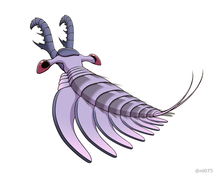Lyrarapax
Lyrarapax is a radiodont of the family Amplectobeluidae that lived in the early Cambrian period 520 million years ago. Its neural tissue indicates that the anomalocaridid frontal appendage is protocerebral, resolving parts of the arthropod head problem and showing that the frontal appendage is homologous to the antennae of Onychophorans and labrum of euarthropods.[1] Its fossilized remains were found in Yunnan in southwestern China. A second species was described in 2016, differing principally in the morphology of its frontal appendages.[2]
| Lyrarapax Temporal range: Chengjiang Biota, Cambrian Period | |
|---|---|
 | |
| Scientific classification | |
| Kingdom: | Animalia |
| Phylum: | Arthropoda |
| Class: | †Dinocaridida |
| Order: | †Radiodonta |
| Clade: | †Amplectobeluidae |
| Genus: | †Lyrarapax Cong et al., 2014[1] |
| Type species | |
| Lyrarapax unguispinus Cong et al., 2014 | |
| Species | |
References
- Peiyun Cong; Xiaoya Ma; Xianguang Hou; Gregory D. Edgecombe; Nicholas J. Strausfeld (2014). "Brain structure resolves the segmental affinity of anomalocaridid appendages". Nature. 513 (7519): 538–42. doi:10.1038/nature13486. PMID 25043032.
- Cong, Peiyun; Daley, Allison C.; Edgecombe, Gregory D.; Hou, Xianguang; Chen, Ailin (2016). "Morphology of the radiodontan Lyrarapax from the early Cambrian Chengjiang biota". Journal of Paleontology: 1. doi:10.1017/jpa.2016.67.
This article is issued from Wikipedia. The text is licensed under Creative Commons - Attribution - Sharealike. Additional terms may apply for the media files.